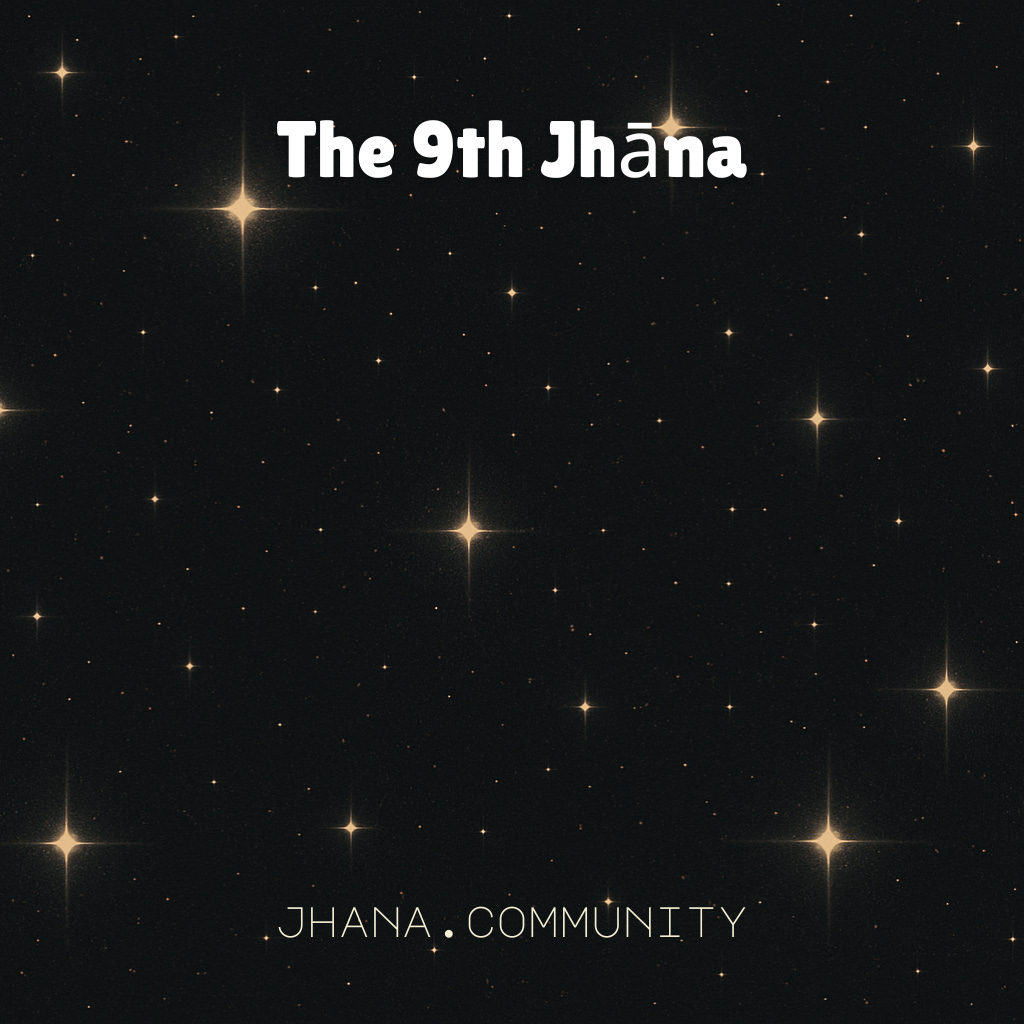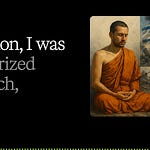Vince Fakhoury Horn: I was thinking about where to start with the 9th Jhāna, and I think the first thing to say is that the 9th Jhāna is not a state. So why in the world are we within a community of practice called The Jhāna Community, which is explicitly aimed at developing and cultivating certain states of mind, or states of consciousness, why would we be focusing on something which is not a state?
Let me let me share a little bit where this term came from. So I'm borrowing this term from a researcher who I spoke to some months ago. This is a researcher working on a project studying advanced meditation. They were asking me about my experience with jhāna's and then asked, “Do you have any experience with anything that would be considered like a 9th Jhāna, or anything beyond the eight traditional jhānas.” And I had to think about that because I'd never heard the term, “the 9th jhāna.” I'd heard other things, weird things, but I hadn't heard that one before, so I thought about it and I was like, “Well, I guess the only thing I would describe as the 9th jhāna is just sort of resting in awareness, or just being open and not doing anything, just being”, what I would normally in my own models call Awareness Meditation, and that is the spirit of this exploration today.
Want to explore the 9th jhāna with Vince Horn? Join him for another round of The 9th Jhāna in The Jhāna Community beginning September 30th, 2025.
The 9th Jhāna is an exploration of how to explore these states of consciousness that arise in meditation naturally and organically when the mind and body are settled, through the doorway of a very different kind of meditation object, which is not an object at all. We take awareness as our “object.”
Of course, awareness can't take itself as an object, right? If you could take awareness as an object, that wouldn't be awareness. It'd be some experience. With the 9th jhāna we're learning how to rest in awareness, to be aware of awareness. And there are lots of ways to do that, and there's lots of ways to think about that.
So today I wanted to kind of just share a few different frames with you, uh, as an attempt to frame the unframeable. Awareness isn't something which we can frame properly because it's not an experience, or it's not a thing, or state. But we still have to talk about it. Because it's like the whole point of the Buddhist meditative tradition in a certain way.
So how can we talk about something that doesn't fit into the normal categories of how we think about reality? One way I think we have to talk about this, and this is a longstanding conversation in the Buddhist contemplative tradition, is we have to talk about how we enter into this awareness of awareness. And there's a longstanding debate here between what in the Buddhist tradition they call the Sudden and Gradual schools. They're not actual real schools, okay. In fact, they're probably not really actual people who really believe either one of these extreme positions anymore.
But, over thousands of years, you could say a dialogue has been happening across these different lines of looking at how the path unfolds. And one of the so-called schools says that the path is a gradual process, it's something that you develop through time. In a book called One Dharma by a Teacher named Joseph Goldstein, he does his best to try to make sense of these different approaches and he describes this kind of approach where you're gradually developing stage by stage or step by step. He calls this the Building From Below orientation. But there's also, as he describes it, a way to Swoop From Above with Awareness. You don't necessarily have to spend 20 years and you know, five Goenka retreats, or whatever the amount of stuff that you did, before you realized the basic truth about awareness, which is: good luck trying to not be aware.
Ken Wilber, one of my early mentors, he used to always point to awareness, he'd say, “Try to stop being aware of my voice.” And Ken talks a lot [laughs] and he'd just keep talking, talking, talking about how you can't not be aware. And it's true, it's hard to shut awareness off.
So here, how do we actually, suddenly realize that we're already aware? This is the Sudden School, which Joseph Goldstein described as Sweeping from Above. You could just realize it's already done. You're already aware, you're already awake.
Sri Nisargadatta Maharaj, in a book called I Am That he said,
“To be aware is to be awake. Unaware means asleep. You are aware anyhow, you need not try to be. What you need is to be aware of being aware. Be aware deliberately and consciously, broaden and deepen the field of awareness. You are always conscious of the mind, but you are not aware of yourself as being conscious.”
I like this way of describing awareness practice, because in a way, he's integrating these two, the sudden and gradual approaches. He's not prioritizing one over the other. He's saying both are true. You're always conscious, right? So consciousness is always present, but you're not always aware that you're aware. You're not always conscious of your consciousness. And so there, that's the practice is being aware of being aware. That's it. That's what we're doing here.
B. Alan Wallace in The Attention Revolution, another awesome Dharma book, that touches on awareness as a doorway into jhāna, he says,
“In awareness of awareness, there is no intentional directing of attention. You simply rest in that flow of knowing, and from time to time gently recognize that you are aware.”
I wish it were more complicated than that, sometimes I wish I could just lay it out like kind of like Daniel Ingram did in his book, Mastering the Core Teachings of the Buddha, and just give you the full, 400 page diagram detail of how to get into awareness. And I'm sure that book exists, and that might be a useful exercise. But for me, the practice is quite simple. And unfortunately, the thinking mind will tend to make this more complex than it is, and that tends to be one of the biggest obstacles that I've noticed in using awareness as a tool for entering into jhāna. So this is one way to look at what we're doing here with the 9th Jhāna. How is it that we're coming into this awareness? Gradually or all of a sudden.
Another way of looking at awareness practice, I think that's very important is that if you are taking a gradual approach, if you feel like there's some kind of movement or development or progression through time, what I've noticed is that that progression often takes one of two forms, and this seems to largely depend on the person and the tradition that they're practicing in.
One of the ways, in the Christian contemplative tradition, they call this Via Negativa. In the Hindu tradition, they call this Advaita, which is you take all of the experiences that are rising and you recognize that you are not any of those, because they're objects, because they're arising, because you can know them. That means they arise in time that they're changing, and they will vanish. This is the basic truth of vipassana, right? Mindfulness. Yeah, so we can recognize that and we recognize anything that we can be aware of is not ultimately who we are. This is the process of, Neti Neti, as it’s said in Sanskrit, “Not this, Not this.”
With this approach you're backing away from the untruth. You're backing away from everything that is not you. You're letting go of all those objects and just resting in awareness that's devoid of any characteristics. Devoid. That's important. This is the path of the void. Not this. Via Negativa.
Then on the other side though, you have the opposite path, Via Positiva. “This too, This too.” Nothing is excluded. Anything that arises that appears to be apart from you, you include it in awareness. You fold it back into awareness and see that thing that I thought was out there, over here, this too!
Shunryū Suzuki Roshi in Zen Mind, Beginner's Mind, he says, “That everything is included within your mind is the essence of mind.” So, here we're recognizing that everything that arises in the mind is the essence of mind.
Another quote from Sri Nisargadatta Maharaj, in I Am That:
“The mind produces thoughts ceaselessly, even when you do not look at them. When you know what is going on in your mind, you call it consciousness. That is your waking state–your consciousness shifts from sensation to sensation, from perception to perception, from idea to idea, in endless succession. Then comes awareness, the direct insight into the whole of consciousness, the totality of the mind. The mind is like a river, flowing ceaselessly in the bed of the body; you identify yourself for a moment with some particular ripple and call it: ‘my thought’. All you are conscious of is your mind; awareness is the cognizance of consciousness as a whole.”
Awareness is the cognizance of consciousness as a whole. Again, we'll use this as our kind of broad definition for what it is that we're meditating on. And of course we don't meditate on awareness. We meditate as awareness. There's no way to take awareness as an object. You can only be that awareness.
So how do you be aware? Well, you're already aware. How do you not be aware? That might be a more interesting question. How do we not be aware? How do we avoid this moment?
So these are two approaches, “Not this, Not this” (via negativa) and “This too, This too.” (via positiva), are both are valid ways to realize Awareness. I remember the first time I really heard this spoken by someone I respected, it was a teacher at Naropa University. I was in this class called Contemplative Hinduism and learning about the different contemplative approaches in the Hindu tradition. My teacher was a woman named Sreedevi Bringi, and she grew up in India and her family, and her family was close friends with Jiddu Krishnamurti, so she grew up, hanging out with Krishnamurti in her family house. Okay, that should give you a little sense of her background.
She said in India there are two basic approaches, and she described it in pretty much the same way I just described them to you, except she said with the Neti, Neti approach, she said in India we call this Advaita Vedanta, radical non-duality. And the other approach “This too, This too”, we call that Tantra. Vedanta and Tantra. And she said both of these are valid approaches. At the time that I heard that, it was really useful, because I'd taken the Via Negativa approach and I thought, “Well, this must be the only way.”
I noticed in the beginning when everyone was sharing about your background, I should have probably asked when your first Goenka retreat was, because almost everyone here seems to have experienced that. And that very much is the Via Negativa approach, where you're just breaking down, deconstructing your experience, disidentifying, you could say dissociating from whatever arises. So this is also, I think, an important frame for understanding the 9th Jhāna, that there are different ways in, that are either about backing away from identification with anything, or moving toward identification with everything. Ultimately, I would suggest these lead to the same realizations.
And then finally, I want to throw this last frame out to you, which is the Several Ways to Meditate framework. This is a framework that my wife, Emily Horn and I developed over many years now to kind of describe the various approaches to meditation that we have practiced, and we teach, to provide a schema for understanding all the different possible ways there are to do this, and how they connect and relate to each other.
If you think for a moment of a hexagram, starting off with a very simple six-sided object. If you look at that hexagram, you can see that there's six points in the hexagram, and each of those points is a style of meditation or a way to meditate. You have Concentration Meditation, bringing attention to a single point. Mindfulness, where we're noticing sensations as they change. Heartfulness, inclining the mind toward opening the heart. Inquiry Meditation where we're using a question as a prompt for discovery, like "What is awareness?" or "Who is aware?" Then you have Imaginal Meditation where you're using internal imagery or other internal senses to kind of put yourself in a position, that you can only imagine, where you're more whole and integrated. And then finally we have Embodiment Meditation where you're working on inhabiting the body.
Now obviously there's a lot of overlaps between these styles. It's not that they're completely separate. In fact, they do connect. And if you imagine this hexagram, every point connecting up to a single point, like a pyramid, except this is a hexagramic pyramid. That single point at the top, the apex, is Awareness. Awareness is the only way of meditating that doesn't have a focus. It's the only style of meditation where there's nothing to do, and thus awareness doesn't contradict any of these other styles of practice. You might be missing that you're aware while you're furiously meditating on your breath or something, you might actually miss that, really it's true. But you can be aware and breathe at the same time. Awareness is compatible with everything, and it's the common denominator of all these styles. It's the point that transcends and includes all these different ways to meditate. So in that sense, it's a kind of special approach. And because of that you can use any of those other styles of meditation, in combination with the intention to be aware of awareness, and you can practice that as a doorway into the 9th jhāna.
So you can practice Mindful Awareness, you can use techniques that intentionally bring in mindfulness, and also point toward awareness. Or you could do a kind of inquiry into awareness. You could use inquiry meditation to, to hone in on the nature of awareness through asking questions. “What is aware of this experience right now?” Can you find that? You can just sit and be in your body. Embodied awareness. You can take awareness as your concentration object. Shamatha without a sign, which was mentioned earlier. You could move through the jhānas naturally and organically as you just rest in awareness, concentrated awareness.
So I mention this model because I'm going to be pulling from a lot of these different techniques over the course of the next 12 weeks. And my hope is that by exploring this from different angles, you can find the approaches to awareness that work for you, to let you in, that are access points for you that are reliable and which you can deepen through. And my experience is sometimes people will find that access point in one place, and it might not be a Goenka retreat, it might be somewhere else. So, here I want to provide as many access points as possible while also continuing to keep the focus centered on the 9th Jhāna.
Practice the 9th Jhāna in The Jhāna Community with Vince Fakhoury Horn. Next group starts on September 30th, 2025.












